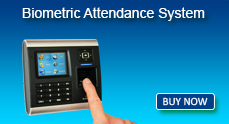Any application requiring authentication or identification can make use of biometrics, this does not mean that using biometrics always has an advantage over other authentication and identification techniques. A few examples where using biometrics might have advantages:
Time Attendance System
The problems with time registration and attendance management are very similar to those encountered with access control. Nowadays most systems identify employees with a pincode or a badge. In practice employees loose their badge or forget their pincode, even worse some employees let collegues who arrive early apply their badge or pincode to the system.
Using biometric time registration or attendance management avoids fooling and also reduces overhead for security personnel when badges are lost or pincodes forgotten. A number of commercial solutions already exists.
Access control to computer systems
Physical access control
Loyalty card
Visitor Management System
Finger Print Readers
Time Attendance Machines
Suitability of fingerprint recognition
How suitable is fingerprint recognition as a biometric solution?
We use the following 7 criteria to evaluate the suitability of fingerprint recognition
Universality :- Only very few people miss all 10 fingers. Most fingerprint recognition software allows to enroll multiple fingers which avoids that an individual is no longer granted access after injury.
Uniqueness: It is generally accepted that fingerprints are unique to an individual. However, there is a risk that fingerprints of two different individuals match if the fingerprint image is of insufficient quality. Therefore the False Acceptance Rate (FAR) is highly dependent on the quality of the fingerprint reader.
Permanence : Fingerprints do not change with ageing, but as people age they lose collagen which makes their fingerprint harder to read and this can lead to significantly more false rejects with elderly people. Injuries, such as fire wounds, can damage a fingerprint but if multiple fingers are enrolled the likelihood of an authorized individual being denied access is reduced.
Collectability: Fingerprints are easy to acquisition, the cheapest fingerprint readers available use a digital camera. Fingerprint readers that are more difficult to fool, such as CMOS readers, are even not overly expensive. In some environments, where for example people are unable to wash their hands, more expensive means might be necessary to acquire a useable fingerprint image.
Acceptability: Fingerprints are easily accepted as soon as people reflect that they leave their fingerprints everywhere and that no sensitive information, such as medical conditions, can be derived from fingerprints.
Circumvention: There are a number of concerns when using fingerprint recognition
A finger can be cut off, this is no joke it already happened. Fingerprint sensors with liveliness detection can resolve this issue.
Fingerprint dummies are not too difficult to make, the effort is highly dependent of the biometric device to be fooled. Some of the cheapest devices can even be fooled by a fingerprint image that is printed on paper or transparency. Dummies can be created for each type of sensor, however in general the more complicated (and thus expensive) sensors are more difficult to fool. Liveliness detection do make fingerprint readers a lot more difficult to fool.
Make a thorough analysis before implementing fingerprint recognition as a means for authentication or identification in a high security environment. Avoid using fingerprint readers without liveliness detection.
Performance: In terms of speed, accuracy and robustness the devices actually on the market should cover any need, except maybe for big corporations and government applications where matching algorithms might become a bottleneck.
Note; False Acceptance Rate (FAR) and False Rejection Rate (FRR) are too dependent on the device, the software implementation and on how the system is used. Therefore we cannot generalize this.





















